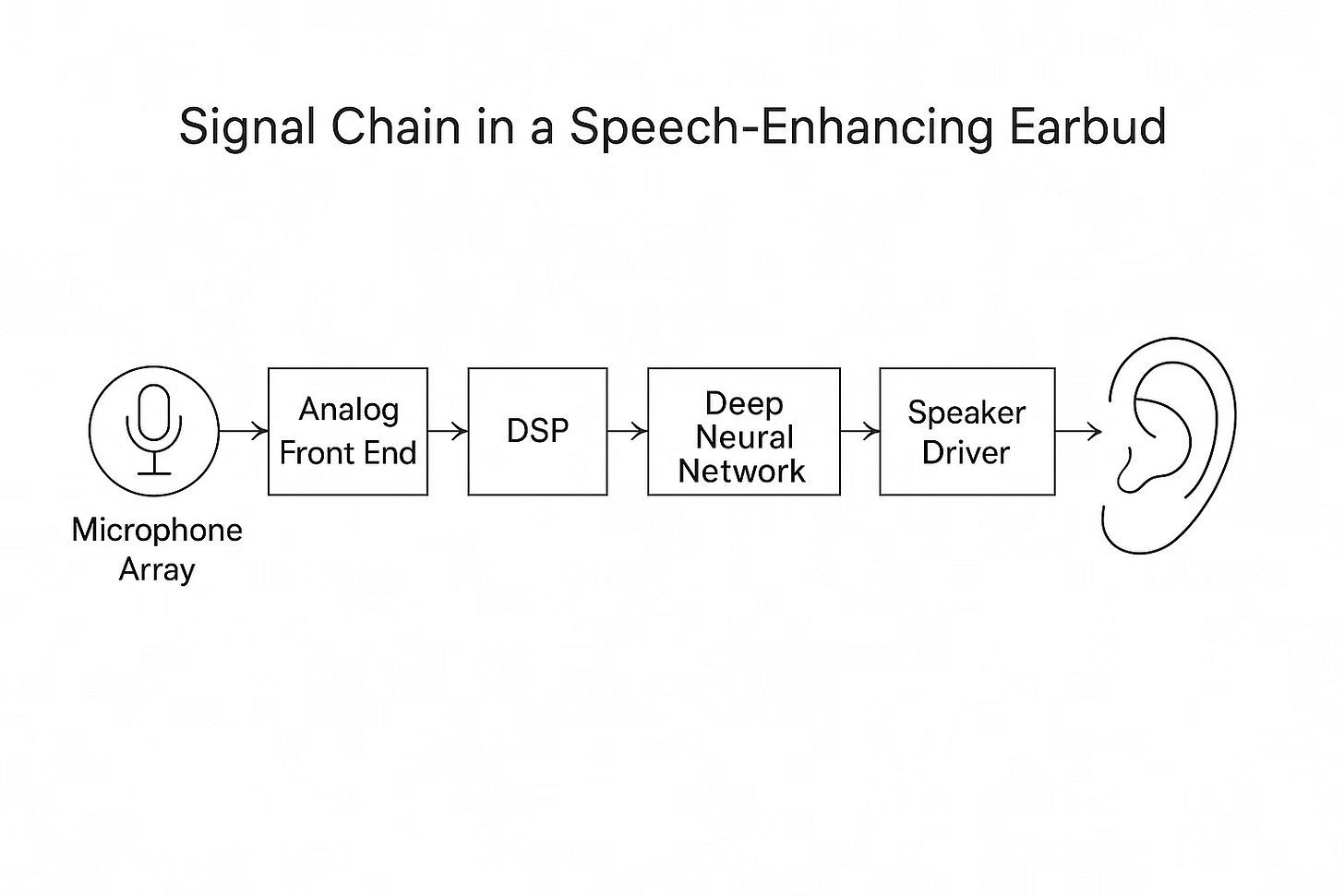There have been some important new developments in hearing aid technology over the last few years.
While a deep dive is beyond the scope of this article, here are some of the key new developments, and why they matter.
Thanks to the Longevity Explorer AI assistant for help researching this post. :)
See Part 1 of this research series: Hearing: "Better Gadgets to Help". Part 1.
New Technology Capabilities
There are several technology building blocks that are driving the new products and use cases described further below. Here is a brief summary for those interested in the technology.
Beamforming microphone array: Steers a virtual microphone toward the dominant talker. Drives signal‑to‑noise ratio (SNR) gains.
Deep‑learning speech separation: Deep Neural Networks (DNNs) trained on millions of audio scenes strip speech from noise. Enables selective lifting of consonants—critical for speech intelligibility.
Bluetooth LE Audio + LC3 codec: Reduces power and improves latency. Preserves lip‑sync and battery life in true‑wireless form factors.
Cartilage / bone conduction transducers: Vibrate outer ear or mastoid, leaving canal open. Situational awareness & hygiene — no occlusion effect.
On‑device room‑acoustic sensing: IMU + mic statistics classify acoustic scenes. Allows automatic mode‑switching without user interaction.
Next-gen Connectivity: Bluetooth LE Audio & Auracast™
Several new communication protocols enable hearing aids and hearables to connect directly to other devices (eg phones, computers, sound systems), better than they were able to in the past.
Bluetooth 5.2‑class low‑energy streaming can significantly extend battery life and lowers latency.
Auracast broadcast audio will let airports, theatres and TVs transmit directly to compatible aids—like a public caption loop, but wireless. (This is a “future” tech that is not yet widely deployed).
Consumer devices (eg. newer Android phones) are turning on Auracast, hopefully accelerating venue adoption.
AI-driven “Smart” Hearing Aids
Modern hearing aids now leverage artificial intelligence (AI) and smartphone connectivity to deliver highly personalized sound experiences. These devices can analyze environments in real time, automatically adjusting settings to optimize clarity in noisy places like restaurants or concerts. For example, brands like Oticon have introduced models which use a deep neural network to process sounds more naturally, mimicking how the human brain interprets audio.
Features like Bluetooth streaming allow users to connect directly to phones, TVs, or music players, transforming hearing aids into wireless earbuds. Some models also support remote programming, enabling audiologists to tweak settings via telehealth appointments, which is especially valuable for those with mobility challenges or in rural areas.
Another exciting development is language translation capabilities in select models, such as those from Starkey, which can provide real-time translation of spoken language, helping users communicate across language barriers — a game-changer for global travelers or multicultural communities. (Note: the actual translation happens on the phone, but you can hear the result through the hearing aid).
The latest hearing aids incorporate some, or all, of the new technologies described earlier in this post.
Here are some examples.
On‑device deep‑learning noise reduction that continuously separates speech from background sound.
Why?: Sharper speech clarity in cafés, cars, stadiums, etc.
Examples: Starkey Edge AI (or older model Genesis AI).
Intent‑sensing multi‑sensor platforms (tiny motion, acoustic & body sensors)
Why?: Aid automatically knows when you turn your head to talk vs. just listening .
Examples: Oticon Intent (2024) is the first with “user‑intent sensors”.
Real‑time cloud/phone AI personalization
Why?: Users can create custom programs and the algorithm learns preferences.
Examples: Widex Moment Sheer uses its PureSound/ZeroDelay engine plus app‑based AI coaching.
Rechargeable and Long-Lasting Designs
The shift from disposable zinc-air batteries to rechargeable lithium-ion batteries has made hearing aids more environmentally friendly and cost-effective. Brands like Phonak and ReSound now offer models with up to 24 hours of use on a single charge, with portable charging cases similar to those for wireless earbuds. For instance, Phonak’s latest products include a charger that can deliver a full day’s power in just a few hours.
This transition reduces the hassle of frequent battery replacements, which can be particularly difficult for older adults with dexterity issues. Some manufacturers are also exploring solar-powered prototypes and energy-efficient chips to extend battery life further, signaling a future where charging might be needed only weekly (this is still in the research stage).
These advancements also lower the long-term cost of ownership, as users no longer need to purchase batteries regularly, making hearing aids more accessible to those on fixed incomes.
Invisible and Discreet Options
Aesthetic concerns have long deterred some individuals from adopting hearing aids, but new designs are nearly invisible. Completely-in-canal (CIC) and Invisible-in-canal (IIC) models, like those from Signia, sit deep within the ear canal, making them undetectable to others. These devices are custom-molded for comfort and use advanced miniaturization to pack powerful tech into tiny forms.
Beyond cosmetics, discreet designs maintain high performance, with features like directional microphones to focus on voices and advanced feedback cancellation to prevent whistling. Some even incorporate health-monitoring sensors, tracking metrics like heart rate or physical activity, blending hearing support with wellness tech.
Manufacturers are also experimenting with skin-tone-matched materials and modular designs that allow users to swap out visible components for a personalized look, appealing to younger users who view hearing aids as a tech accessory rather than a medical device.
References
Excellent Starkey reviews with much detail on the technology inside including Deep Neural Network (DNN): Hearing Tracker Review
For in-depth reviews of hearing aids, some of the Longevity Explorers found the site Hearing Tracker very useful: Hearing Tracker website.





Very nice review of new high-tech improvements for hearing aids!
I've been following developments in my own hearing devices, but have not yet heard of any breakthroughs such as using AI to filter out background noise.
My latest problem is definitely low-tech - Costco is now supplying 312 zinc-air batteries in child-proof packaging, which are also elder-proof.